Archived Mold Remediation Blog Posts
Trust SERVPRO Team JRF for Mold Remediation
11/25/2024 (Permalink)
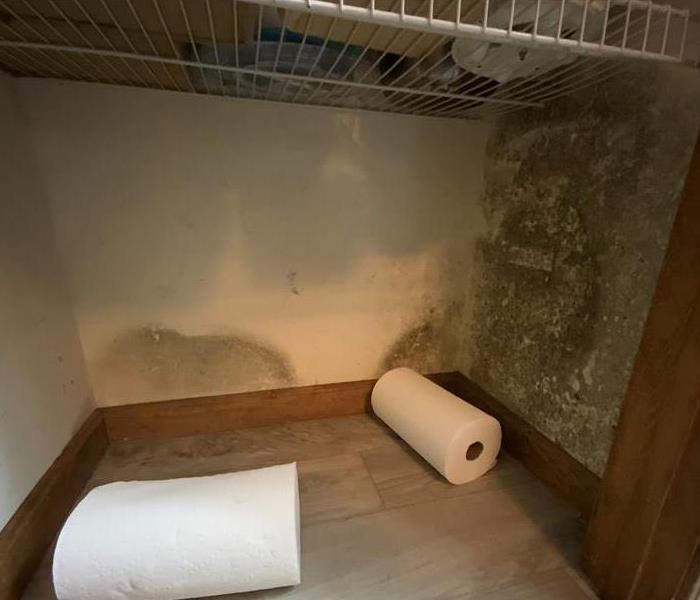 Find mold in your kitchen cabinets - call SERVPRO Team JRF.
Find mold in your kitchen cabinets - call SERVPRO Team JRF.
Mold in Your Kitchen Cabinets: Causes, Risks, and Solutions
Your kitchen is the heart of your home, but it can quickly become a breeding ground for mold if moisture, warmth, and organic materials meet. One area often overlooked? Your kitchen cabinets. Mold can sneak into these spaces, causing health concerns, property damage, and unpleasant odors. At SERVPRO® Team JRF, we’re here to help you understand the causes, risks, and solutions for mold in your kitchen cabinets.
How Does Mold Get in Your Kitchen Cabinets?
Leaks and Spills:
Water leaks from pipes, sinks, or appliances often go unnoticed in the enclosed spaces of cabinets. Even minor spills left unaddressed can seep into cabinet surfaces and foster mold growth.
High Humidity Levels:
Kitchens are naturally humid due to cooking, dishwashing, and boiling water. Without proper ventilation, this humidity can linger and create a perfect environment for mold.
Poor Cleaning Habits:
Food crumbs and grease trapped in cabinets provide the organic material mold needs to thrive. Neglecting regular cleaning makes it easier for spores to settle and grow.
Old or Damaged Cabinets:
Over time, cabinets made from porous materials like wood or particleboard may absorb moisture. Cracks or peeling finishes can also expose inner layers to dampness.
Why You Shouldn’t Ignore Mold
Mold in your kitchen cabinets isn’t just an eyesore; it poses serious risks:
- Health Hazards: Mold can potentially cause health effects.
- Structural Damage: Mold eats away at wood and other organic materials, compromising the integrity of your cabinets over time.
- Spread to Other Areas: Mold doesn’t stay put. If left untreated, it can spread to walls, flooring, and other parts of your home, leading to costly repairs.
How SERVPRO Team JRF Can Help
At SERVPRO Team JRF, we specialize in mold remediation to ensure your kitchen is safe and clean. Here’s how we can assist:
Inspection and Assessment:
Our experts use advanced tools to identify mold growth, even in hidden areas like behind cabinets or under sinks.
Containment:
To prevent mold from spreading, we seal off affected areas using specialized barriers and negative air pressure systems.
Mold Removal:
Using industry-leading techniques, we safely remove mold and any contaminated materials.
Cleaning and Deodorization:
We clean and sanitize your kitchen to eliminate spores and odors, leaving it fresh and safe.
Prevention Tips:
Our team provides guidance on keeping your kitchen mold-free, including advice on ventilation, moisture control, and regular cleaning.
Proactive Steps You Can Take
While professional remediation is crucial for significant mold problems, these steps can help prevent mold in the first place:
- Fix leaks immediately and inspect pipes regularly.
- Use a dehumidifier or kitchen exhaust fan to reduce moisture levels.
- Clean and organize your cabinets regularly, especially around food storage.
- Line cabinets with moisture-resistant material to protect porous surfaces.
Trust SERVPRO Team JRF for Mold Remediation
Don’t let mold take over your kitchen or compromise your health. At SERVPRO Team JRF, we’re committed to restoring your home and peace of mind. If you suspect mold in your kitchen cabinets, don’t wait—contact us today. We’ll make it "Like it never even happened."
Ready to tackle mold? Call SERVPRO Team JRF or visit our website to schedule your inspection.
Mold Remediation in the Bedroom: A Laughable Look at a Serious Issue
9/3/2024 (Permalink)
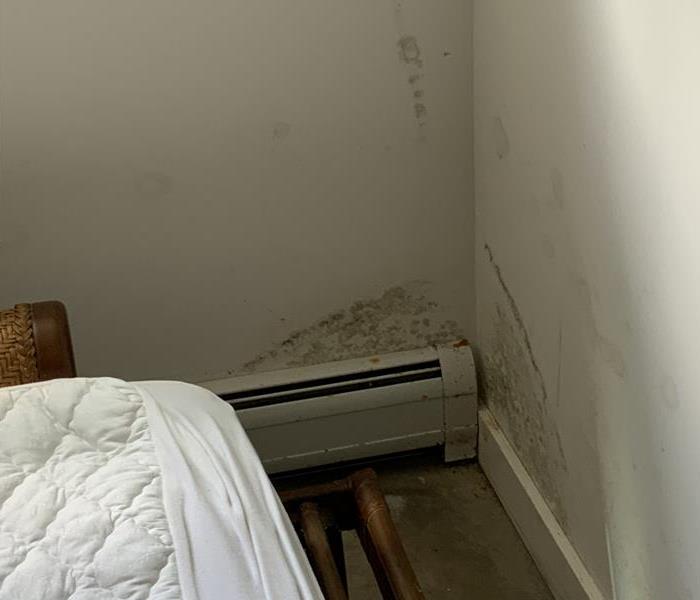 Sleep tight and don’t let the mold bugs bite – unless they’re the SERVPRO variety, of course!
Sleep tight and don’t let the mold bugs bite – unless they’re the SERVPRO variety, of course!
So, you've discovered a surprise guest in your bedroom – and no, it’s not the in-laws or an unexpected visit from your college roommate. It’s mold. Yes, that pesky fungus has decided your cozy sleeping quarters are the perfect place to set up shop. While mold might not be the most charming roommate, you can laugh about it and get things sorted with a little help from us at SERVPRO®!
When Mold Moves In
First things first: let’s understand how mold might have decided your bedroom was the ultimate Airbnb. Mold thrives in damp, warm environments. If your bedroom is prone to leaks, high humidity, or poor ventilation, it might as well have a "Welcome" mat for mold spores. Think of it like the mold’s way of giving you a slightly creepy wake-up call!
Step 1: Assess the Situation
Before we roll up our sleeves and dive into the nitty-gritty of remediation, it’s time to assess the situation. Grab a flashlight and a magnifying glass – just kidding, you don’t need a magnifying glass. But a flashlight and a keen eye can help you spot mold in hidden corners, under the bed, or behind the wardrobe. If you find any mold, try to resist the urge to host a tiny mold convention – it’s time to call in the experts!
Step 2: Call in the Pros
Mold might be a home invader, but that doesn’t mean you should try to tackle it alone. It’s like trying to clean up glitter after a craft project – you need the right tools and a lot of patience. That’s where SERVPRO comes in. We’re equipped with all the gear to make sure your mold problem is dealt with swiftly and efficiently.
Step 3: The Remediation Process
Here’s where the magic happens – and by magic, we mean professional-grade equipment and techniques. We’ll start by containing the affected area to prevent mold from spreading to other parts of your home. Next, we’ll remove and dispose of any contaminated materials. We don’t just wipe down the surface – we dive deep into the problem. Think of us as the mold’s least favorite house guests.
Step 4: Cleaning and Drying
Once we’ve kicked mold to the curb, we’ll clean and dry out your bedroom. Our high-powered air movers and dehumidifiers will make sure everything is dry and clean. We’ll also use special antimicrobial treatments to keep mold from making a comeback. Imagine us as the ultimate mold-busting superhero squad, minus the capes (but not the awesome gear).
Step 5: Prevention Tips
To keep mold from moving back in, consider some easy prevention tips. Ensure good ventilation in your bedroom – that means opening windows, using exhaust fans, and maybe even investing in a dehumidifier. Keep an eye out for leaks and address them promptly. And remember, while mold might be good at showing up uninvited, it’s not great at staying away if it finds a welcoming environment.
Wrapping Up
So there you have it – a humorous yet practical guide to dealing with mold in your bedroom. While the presence of mold is no laughing matter, it’s good to know that with SERVPRO’s help, you can turn this unwelcome guest into a thing of the past. If you suspect mold is making your bedroom its new home, don’t hesitate to call us. We promise to kick the mold out and leave your bedroom ready for peaceful, mold-free dreams.
Sleep tight and don’t let the mold bugs bite – unless they’re the SERVPRO variety, of course!
SERVPRO's Expertise in Mold Remediation
5/2/2024 (Permalink)
Introduction: Mold is a pervasive issue that threatens both property integrity and human health. In Hollis, Peterborough, and Weare, where moisture-rich environments are common, mold can quickly become a problem. At SERVPRO of Hollis, Peterborough, Weare, we understand the significance of mold remediation and the importance of addressing it promptly. In this comprehensive guide, we delve into the impact of mold, the necessity of professional restoration, signs of mold presence, health risks, the shortcomings of DIY approaches, our meticulous remediation process, tools and techniques we employ, prevention strategies, and the role of mold remediation in property value maintenance.
Understanding Mold: In our service areas of Hollis, Peterborough, and Weare, mold thrives in damp conditions, posing risks to property structures and occupants' health. It's crucial to recognize the signs of mold and take proactive measures to address it.
The Need for Professional Restoration: SERVPRO of Hollis, Peterborough, Weare specializes in professional mold remediation, ensuring thorough eradication and preventing future recurrences. Our expertise and advanced techniques guarantee safe and effective restoration, safeguarding both property value and occupants' well-being.
Signs of Mold Presence: Musty odors, discolored surfaces, peeling wallpaper, and health symptoms like sneezing and coughing are indicators of mold presence that warrant immediate action. SERVPRO's rapid response team is ready to assess and address any mold issues in Hollis, Peterborough, and Weare promptly.
Health Risks Associated with Mold Exposure: Exposure to mold spores can lead to allergies, asthma, and respiratory issues, particularly affecting vulnerable individuals. SERVPRO's professional remediation services prioritize the health and safety of our clients in Hollis, Peterborough, and Weare.
Why DIY Mold Removal is Inadequate: DIY methods often fall short in addressing hidden mold and may lead to incomplete removal, posing health risks and property damage. SERVPRO's comprehensive approach ensures thorough remediation and long-term protection for properties in Hollis, Peterborough, and Weare.
The Process of Professional Mold Remediation: SERVPRO of Hollis, Peterborough, Weare follows a meticulous process, utilizing advanced tools and techniques for detection, containment, eradication, and prevention of mold. Our expert team ensures that properties are restored to a safe and healthy condition.
Tools and Techniques Used in Professional Restoration: Moisture meters, infrared cameras, air scrubbers, HEPA vacuums, and specialized chemicals are among the tools and techniques employed by SERVPRO to achieve effective mold remediation in Hollis, Peterborough, and Weare.
Preventing Future Mold Growth Post-Remediation: After remediation, SERVPRO focuses on preventive measures such as fixing leaks, improving ventilation, and enhancing airflow to inhibit mold recurrence in properties across Hollis, Peterborough, and Weare.
The Role of Mold Remediation in Property Value Maintenance: SERVPRO's professional mold remediation services not only protect health but also preserve and enhance property value by eliminating mold infestations. Property owners in Hollis, Peterborough, and Weare can trust SERVPRO to maintain their investments.
Conclusion: SERVPRO of Hollis, Peterborough, Weare is committed to providing top-notch mold remediation services to protect properties and occupants in our service areas. With our expertise, advanced techniques, and dedication to customer satisfaction, we ensure that mold issues are addressed effectively and properties are restored to a safe and healthy condition. Trust SERVPRO for all your mold remediation needs in Hollis, Peterborough, and Weare.
The Hidden Dangers of Mold in Your Home: Health Risks and Prevention Tips
10/23/2023 (Permalink)
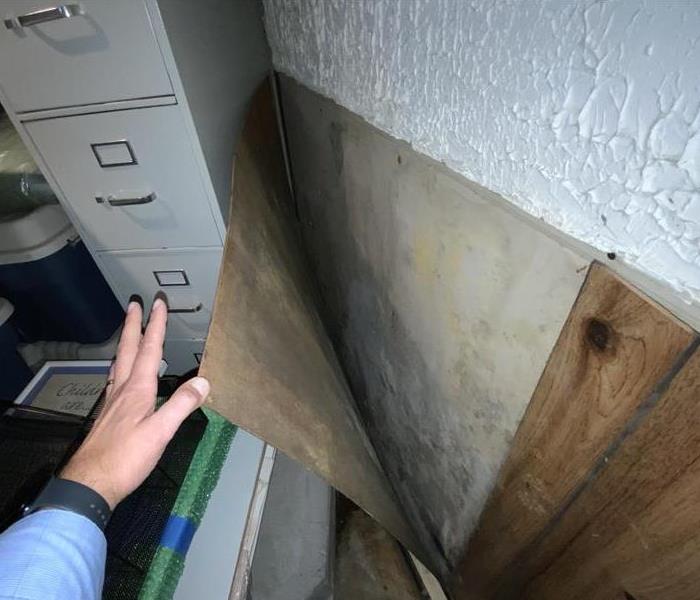 SERVPRO provides full mold remediation for residential and commercial customers in the Salem/Peabody/Marblehead area.
SERVPRO provides full mold remediation for residential and commercial customers in the Salem/Peabody/Marblehead area.
Mold is a common household issue that often goes unnoticed until it becomes a significant problem. While it may seem harmless, mold can pose serious health risks to you and your family. In this blog post, we will explore the hidden dangers of mold in your home and provide practical tips for preventing and managing mold growth.
Understanding Mold:
Mold is a type of fungus that thrives in damp and humid environments. It reproduces by releasing tiny spores into the air, which can settle on various surfaces and grow into new mold colonies. While not all molds are harmful, some can produce mycotoxins and allergens that can have adverse effects on your health.
Health Risks Associated with Mold:
Respiratory Issues: Exposure to mold can lead to a range of respiratory problems, such as coughing, wheezing, and throat irritation. People with allergies and asthma are particularly vulnerable to these effects.
Allergic Reactions: Mold spores can trigger allergic reactions in some individuals, causing symptoms like sneezing, runny nose, and itchy eyes.
Skin Irritation: Contact with mold or moldy surfaces can sometimes lead to skin rashes and irritation.
Fungal Infections: In rare cases, individuals with compromised immune systems may develop fungal infections from mold exposure.
Neurological Symptoms: Some studies suggest a possible link between mold exposure and neurological symptoms, though more research is needed in this area.
Prevention and Management:
Preventing mold growth in your home is essential for maintaining a healthy living environment. Here are some tips to help you keep mold at bay:
Control Moisture: Since mold thrives in damp conditions, the most effective way to prevent it is by controlling moisture. Repair any leaks promptly, use exhaust fans in bathrooms and kitchens, and maintain proper ventilation.
Monitor Humidity Levels: Keeping indoor humidity levels below 50% can inhibit mold growth. Consider using dehumidifiers in areas prone to high humidity.
Regular Cleaning: Regularly clean and dust your home to remove mold spores. Pay close attention to areas like the bathroom, kitchen, and basement.
Proper Insulation and Ventilation: Ensure your home is well-insulated to prevent condensation on walls and ceilings. Proper ventilation can also help circulate air and reduce moisture buildup.
Immediate Remediation: If you discover mold in your home, address it immediately. Small outbreaks can often be cleaned with mold-specific cleaning products, but larger infestations may require professional remediation.
Reduce Clutter: Reduce clutter in your home, as it can provide hiding spots for mold to grow unnoticed.
Conclusion:
Mold is not something to be taken lightly. Its hidden dangers can affect your health and well-being. By understanding the health risks associated with mold and implementing prevention strategies, you can create a safer and healthier living environment for you and your family. Be proactive in managing mold to ensure a mold-free, comfortable, and safe home.
Factors to consider when hiring a professional mold remediation company.
4/24/2023 (Permalink)
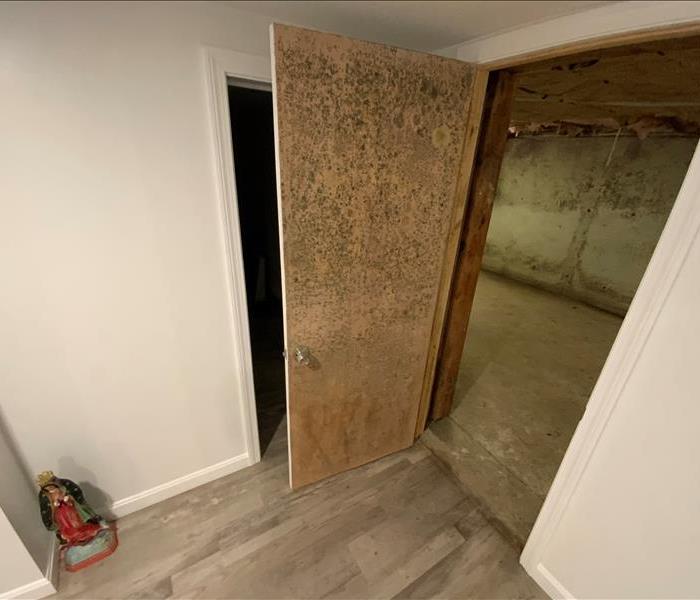 Mold grows in humid, dark spaces.
Mold grows in humid, dark spaces.
When hiring a mold remediation service, there are several factors to consider to ensure that you choose a reputable and reliable company. Here are some key considerations:
Experience and Expertise: Choose a company with years of experience and knowledge of mold remediation techniques. Ask for references and check online reviews to see what previous customers have to say about their work.
Certifications and Licenses: Verify that the company holds relevant certifications and licenses from reputable organizations. Look for certifications such as the IICRC (Institute of Inspection Cleaning and Restoration Certification) or NORMI (National Organization of Remediators and Mold Inspectors).
Insurance: Make sure the company has liability insurance to protect you in case of any accidents or damages that may occur during the remediation process.
Process and Equipment: Inquire about the mold remediation process the company follows and the equipment they use. Ensure that the company uses appropriate protective gear, ventilation, and proper containment techniques to avoid the spread of mold spores.
Cost: Get quotes from multiple companies and compare their prices. Be wary of companies that offer significantly lower prices than others, as they may be cutting corners or using inferior equipment.
Communication: Choose a company that communicates well and is responsive to your needs. The company should provide you with a detailed plan of action, including an estimated timeline and cost breakdown.
Guarantee: Ask if the company offers a guarantee or warranty on their work. A reputable company should stand behind their work and be willing to address any issues that may arise after the remediation process is complete.
For professional and certified mold remediation please contact SERVPRO of Salem/Peabody/Marblehead.
Does Homeowner's Insurance Cover Mold Damage?
3/12/2019 (Permalink)
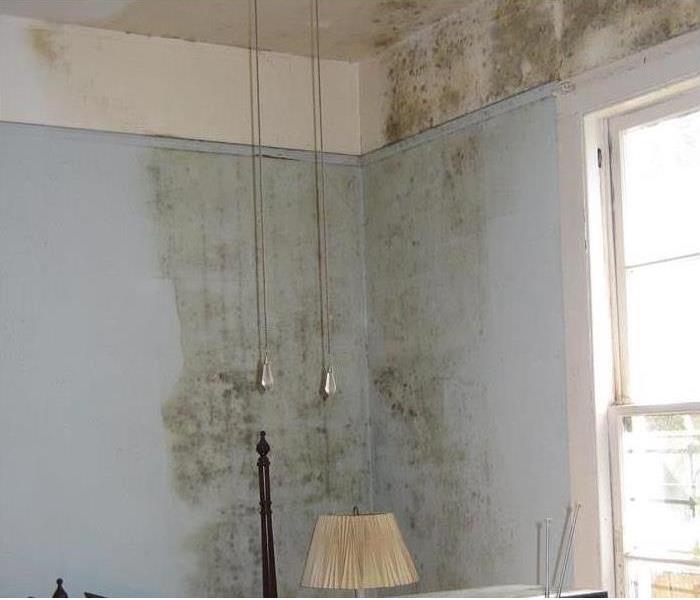 Mold found in an Essex County home
Mold found in an Essex County home
Some homeowner’s insurance does cover mold. However, the mold covered under insurance must fall under covered peril. The language of your policy includes the conditions qualifying for a covered peril.
Keep in mind, insurance companies limit the amount of coverage they offer so that additional coverage may cost a lot more. Again, it all depends on your insurance policy stipulations. There are also different types of claims to consider depending on your status as an owner with tenants or the owner or renting party.
First Party Coverage Claims
When you have mold in your home and make a claim with your insurance company, it’s known as a first-party property claim. You must be the policyholder to receive insurance coverage for the claim.
Third Party Coverage Claims
If you rent a home or apartment and your tenants file an insurance claim for mold, this falls under the third-party claim.
Tips for Dealing with Mold Damage
Whether insurance covers the mold in your home, you must address it as soon as possible. Allowing it to grow can lead to health problems, such as respiratory issues, throat irritation, and others. Mold thrives in moist areas. If your home has vulnerabilities to water leaks, you must address the incident within two days. Doing so can mitigate some of the health risks and property damage brought on by mold.
Other Tips for Handling Mold
The best way to handle mold is to prevent its growth at the onset. You can limit mold growth by doing the following:
- Use air humidifiers and air conditioners to keep air moisture between 30 percent and 60 percent
- Do not place carpets or rugs in damp areas such as basements
- Fix small leaks immediately
- Inspect faucet fixtures and nozzles under sinks and toilets to check for leaks
There are several measures you can take to decrease the chances of mold growth. It is especially important in humid states where moisture collects easily in different parts of the home.
Do you need more information about dealing with mold damage or mold remediation? Our trained mold specialists at SERVPRO of Salem/Peabody/Marblehead offer 24-hour emergency services. Using the most advanced technology, our team keeps the mold from spreading any further damage. Call us today at 978.744.4545
How Mold Can Affect Your Health
3/6/2019 (Permalink)
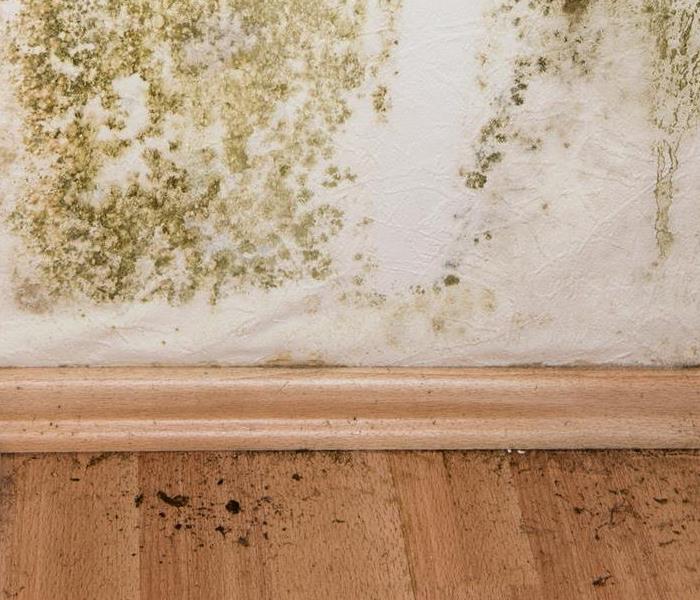 Keep your home healthy and free from mold!
Keep your home healthy and free from mold!
Chronic inflammatory response syndrome (CIRS) is a serious, multi-symptom illness that negatively impacts more than one system in the body. Most often is it caused by exposure to harmful biotoxins or neurotoxins in our environment. These toxins may be caused by:
- Mold in the home.
- Pfiesteria – Microscopic organism that produces toxins known to cause large fish kills.
- Cyanobacteria – Commonly found in lakes and rivers.
- Lyme disease – Transmitted by tick bites.
- Poisonous spider bites.
- Ciguatera – A toxin affecting reef fish that are often consumed by humans.
The effects of this inflammatory syndrome vary depending on the person and their experience. However, the respiratory, neurological, psychological, and gastrointestinal symptoms can be life-changing, no matter the source, which is why it is essential to know the signs and see your doctor if you think you have it. Remember, mold allergies are not the same as mold illness, so it is critical to determine the reason for your symptoms. If you recently had flooding in your home or the interior of your household has been humid, you will also want to determine if your symptoms of CIRS are being caused by exposure to mold in your home.
Characteristics of CIRS From Mold Exposure
It is important to know that the effects of chronic inflammatory response syndrome from mold exposure will present itself differently than if it was caused by something else, such as a spider bite, a burn or lyme disease. In fact, when a person develops this syndrome due to mold exposure specifically, they will usually experience some of these symptoms, in addition to those mentioned above:
- Headache
- Sinus congestion
- Sore throat
- Nosebleeds
- Itchy eyes
- Cough
- Flu symptoms
- Wheezing
- Stomach ache
These symptoms are also typical signs of illnesses like influenza, indoor and outdoor allergies, and the common cold, so it is important to see your physician if you have them.
Checking Your Home for Signs of Mold
No matter the cause, chronic inflammatory response syndrome is a severe illness with lasting consequences. In many cases, it does develop as a result of toxic mold exposure, which is why it is important to have your home checked if you or your doctor think mold may be causing your symptoms. A professional mold inspection completed by an experienced technician will determine if mold is present, and they will let you know what needs to be done to safely remove it.
SERVPRO of Salem/Peabody/Marblehead is staffed with experienced experts that come to your home for a mold consultation. Call us today at 978.744.4545
Does Your Salem, Peabody or Marblehead Home Have A Mold Problem?
3/3/2019 (Permalink)
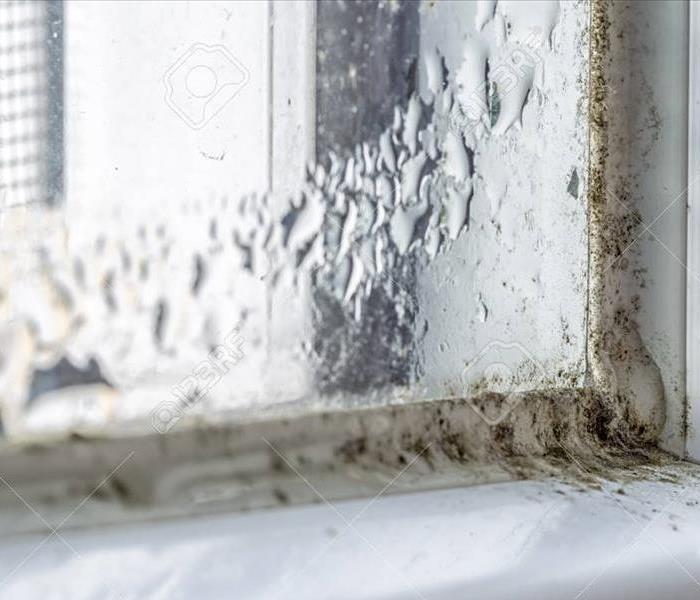 Mold can spread through a home in as little as 48 hours.
Mold can spread through a home in as little as 48 hours.
Microscopic mold spores naturally occur almost everywhere, both outdoors and indoors. This makes it impossible to remove all mold from a home or business. Therefore, mold remediation reduces the mold spore count back to its natural or baseline level. Some restoration businesses advertise “mold removal” and even guarantee to remove all mold, which is a fallacy. Consider the following mold facts:
- Mold is present almost everywhere, indoors and outdoors.
- Mold spores are microscopic and float along in the air and may enter your home through windows, doors, or AC/heating systems or even hitch a ride indoors on your clothing or a pet.
- Mold spores thrive on moisture. Mold spores can quickly grow into colonies when exposed to water. These colonies may produce allergens and irritants.
- Before mold remediation can begin, any sources of water or moisture must be addressed. Otherwise, the mold may return.
- Mold often produces a strong, musty odor and can lead you to possible mold problem areas.
- Even higher-than-normal indoor humidity can support mold growth. Keep indoor humidity below 45 percent.
If your home or business has a mold problem, we can inspect and assess your property and use our specialized training, equipment, and expertise to remediate your mold infestation.
If You See Signs of Mold, Call Us Today – 978.744.4545
Follow These Mold Safety Tips If You Suspect Mold
10/25/2018 (Permalink)
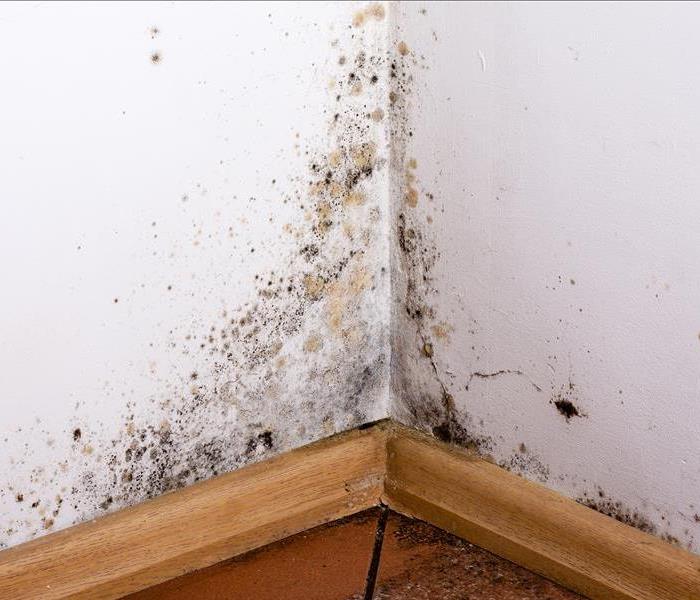 Be careful! Without proper training, you could be spreading mold throughout your home.
Be careful! Without proper training, you could be spreading mold throughout your home.
If you see visible mold, do not disturb it. You can inadvertently spread the mold infestation throughout your home. When mold is disturbed, the mold can release microscopic mold spores which become airborne and can circulate inside your home.
What to Do:
- Stay out of affected areas.
- Turn off the HVAC system and fans.
- Contact SERVPRO of Salem/Peabody/Marblehead for mold remediation services.
What Not to Do:
- Don’t touch or disturb the mold.
- Don’t blow air across any surfaces with visible or suspected mold growth.
- Don’t attempt to dry the area yourself.
- Don’t spray bleach or other disinfectants on the mold.
About Our Mold Remediation Services
SERVPRO of Salem/Peabody/Marblehead specializes in mold cleanup and restoration, in fact, it’s a cornerstone of our business. Our crews are highly trained restoration professionals that use specialized equipment and techniques to properly remediate your mold problem quickly and safely.
If You See Signs of Mold, Call Us Today – 978.744.4545
Commercial Mold Remediation in Essex County
5/24/2018 (Permalink)
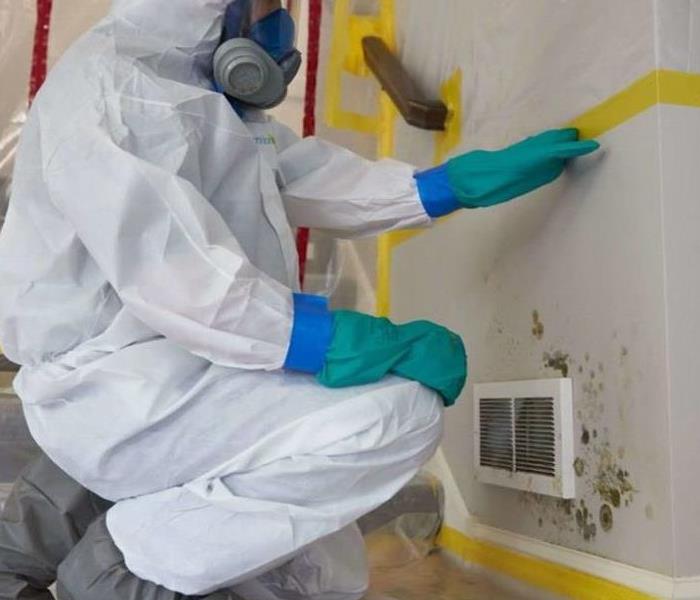 Mold can be a serious problem for your business.
Mold can be a serious problem for your business.
Besides causing a major business interruption, a mold problem can present a serious health risk for people exposed at your commercial property. Mold infestations can be caused by minor water intrusions, like a slow roof leak or loose plumbing fitting. Every hour spent cleaning up is an hour of lost revenue and productivity. If you suspect your property has a mold problem, call SERVPRO of Salem/Peabody/Marblehead, who will respond quickly and work fast to manage the situation.
- 24 Hour Emergency Service
- Faster to Any Size Disaster
- A Trusted Leader in the Mold and Water Restoration Industry with over 1,700 Franchises
- Highly Trained Mold and Water Damage Restoration Specialists
Have a Mold Problem? Call Us Today – 978.744.4545
Commercial Mold Remediation Presents Unique Challenges
Mold can spread quickly through a property if left untreated. SERVPRO of Salem/ Peabody/ Marblehead can respond quickly, working to first contain the infestation to help prevent its spread to other parts of the building. Next, we will begin the remediation process, working safely and effectively to manage the situation. We have the training, experience, and equipment to contain the mold infestation and remediate it to preloss condition. Learn more about SERVPRO of Salem/Peabody/Marblehead training and certifications.
- Applied Microbial Remediation Specialist
- Water Damage Restoration Technician
- Applied Structural Drying Technician
- Odor Control Technician
- Upholstery and Fabric Cleaning Technician
Mold Removal vs. Mold Remediation
5/24/2018 (Permalink)
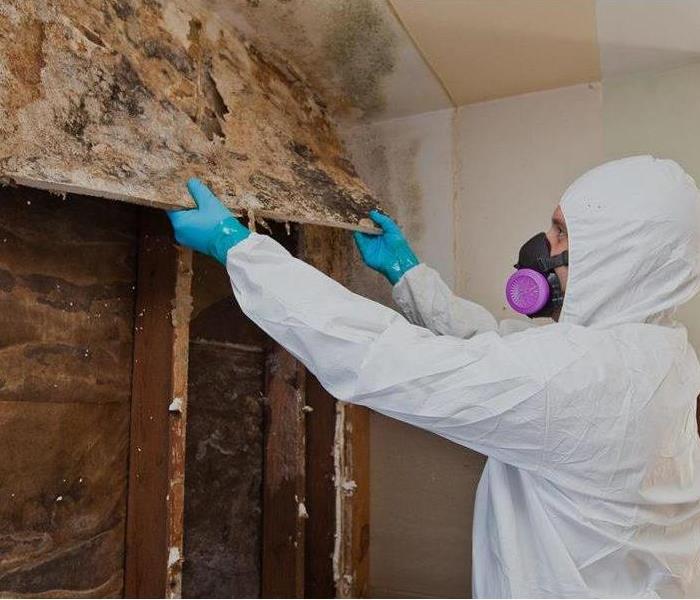 Mold remediation
Mold remediation
What’s the Difference?
Since microscopic mold spores exist naturally almost everywhere, indoors and outdoors, removing all mold from a home or business is impossible. Many restoration businesses advertise “mold removal” and even guarantee to remove all mold. This is a fallacy. We understand mold and mold growth. SERVPRO of Salem/Peabody/ Marblehead has the training and expertise to remediate the mold in your home or business.
Signs of Mold? Call Today – 978.744.4545
Understanding Mold
When water intrudes into your property, mold growth can start in as little as 48 hours. Consider the following mold facts:
- Mold is present almost everywhere, indoors and outdoors.
- Mold spores are microscopic, float along in the air, and may enter your home through windows, doors, or AC/heating systems or even hitch a ride indoors on your clothing or a pet.
- Mold spores thrive on moisture. Mold spores can quickly grow into colonies when exposed to water. These colonies may produce allergens and irritants.
- Before mold remediation can begin, any sources of water or moisture must be addressed. Otherwise, the mold may return.
- Mold often produces a strong, musty odor, and that odor can lead you to possible mold problem areas.
- Even higher-than-normal indoor humidity can support mold growth. Keep indoor humidity below 45 percent.
The Mold Remediation Process
Every mold damage scenario is different and requires a unique solution, but the general mold remediation process stays the same.
- Emergency Contact - 978.744.4545
- Inspection and Mold Damage Assessment
- Mold Containment
- Air Filtration
- Removing Mold and Mold-Infested Materials
- Cleaning Contents and Belongings
What You Should Know About Mold Remediation and Removal
3/1/2018 (Permalink)
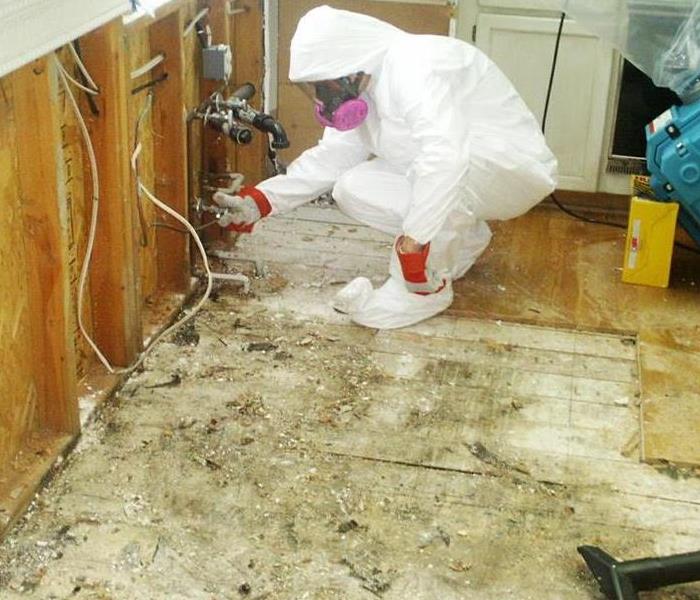 Mold needs to be professionally identified and remediated.
Mold needs to be professionally identified and remediated.
Mold is found under the fungi classification. It is a soft green or at times grey growth which develops on objects or old food left for a lengthy period in warm, wet air. It can be found in outdoor and indoor places, thus, it is important for the indoor humidity to be kept below forty-five percent because a higher humidity supports the growth of this class of fungus. Floods and high humidity levels often lead to microbial growth and fungus. Microbial growth can be present in an area, but that does not classify it as mold. The most efficient method of controlling microbial growth is by the moderation of temperature. When the temperature is lowered, the rate of microbial growth decreases rapidly.
Mold and mildew are two fungi that people often tend to confuse. Mildew appears to be powdery and white in color then later turns to brown, black or yellow. The other fungus seems fuzzy but can appear in similar colors as the mildew. Mildew damages crops while molds damage the structural foundations of homes. Both fungi are usually accompanied by a musty odor which can lead to more health issues. It likes to thrive in moisturized areas and grows quickly into colonies with water exposure. These colonies are responsible for the production of irritants and allergens that affect the health of people.
For mitigation of mold to take place, all sources of moisture and water need to be addressed otherwise it may regrow. The first step is to remove all traces of moldy growth immediately. Five fundamental principles must be applied by homeowners and employers to ensure successful mitigation of this fungus. They should focus on the source and moisture removal, safety, contamination control and assessment. Proper mitigation is essential once the fungi is removed because areas must be monitored to prevent it from occurring again.
It is important to determine the party that will be in charge of the mold cleanup. An environmental hygienist can determine what treatment can be used for this fungus. These hygienists mitigate the problem by sealing off the affected areas with plastic sheets to stop dispersion of the spores. Fungus should be dealt with by the wearing a face mask with high filtration and neoprene gloves. Once the mold cleanup is finished, the air around it needs to be cleaned using air exchange and scrubbers.
It is essential for the environmental hygienist to have a protective suit because harsh chemicals are used for the mold cleanup. Hard surfaces with moldy growth have to be scrubbed with water and detergent and left to dry completely. Porous materials like carpets and ceiling tiles need to be disposed of by the environmental hygienists if they get moldy. The crevices of these porous materials are prone to mold growth, and painting can only happen once the environmental hygienists complete the mold cleanup otherwise the paint peels off. The correct mitigation strategies need to be employed for effective cleanup.
Visit www.SERVPROsalem.com for more information on mold remediation.
Mold Tips...Don't Be Afraid To Ask
3/1/2018 (Permalink)
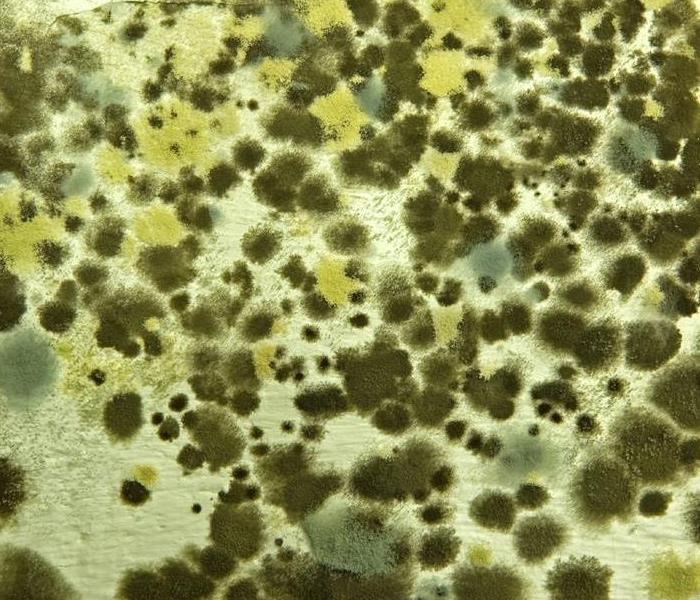 Questions about mold? Don't be afraid to ask!
Questions about mold? Don't be afraid to ask!
The wet winter and fluctuating temperatures create a favorable environment for mold issues this spring. Changes in weather create stress on structures. Structures that are stressed are prone to moisture and water issues. Mold is a secondary damage to water damage or excessive moisture. Preventing mold is a matter of keeping a structure dry by quickly repairing or cutting off a source of moisture and when you have a leak or larger issue, having it properly repaired.
Here are some Mold basics:
- Mold exposure can cause health effects.
- The best way to control indoor mold growth is to eliminate sources of moisture.
- If mold is a problem in your home or school, you must clean up the mold and eliminate sources of moisture. Do this by fixing the source of leaks; reduce humidity in the atmosphere with proper ventilation and dehumidification if necessary; properly dry all building materials and furnishings if you have a floor or major leak.
- Insulate around windows and piping to minimize condensation on cold surfaces.
- Mold can only grow on organic materials (wood, paper, carpets and foods).
- The EPA recommends that homeowners limit their mold cleaning to small effected areas, 3ft x 3ft. The reason is mold spores are very difficult to kill and it is very easy to cross contaminate an area with the invisible spores.
SERVPRO of Salem/Peabody/Marblehead is certified to clean and remove mold and we are happy to answer any questions you have. Give us a call at 978.744.4545 if you want to discuss a mold issue or are in need of help.
Follow These Mold Safety Tips If You Suspect Mold
2/19/2018 (Permalink)
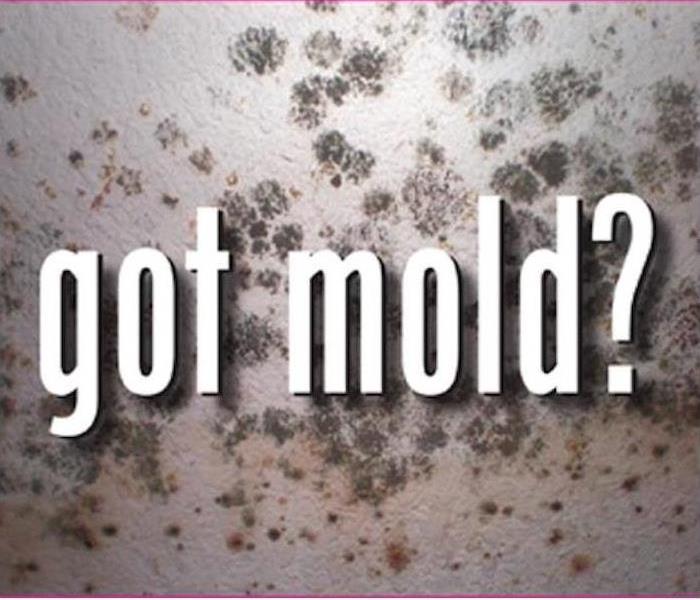 Be careful! Without proper training, you could be spreading mold throughout your home.
Be careful! Without proper training, you could be spreading mold throughout your home.
If you see mold, do not disturb it. You can inadvertently spread the mold infestation throughout your home. When mold is disturbed, the mold can release microscopic mold spores which become airborne and can circulate inside your home.
What to Do:
- Stay out of affected areas.
- Turn off the HVAC system and fans.
- Contact SERVPRO of Salem/Peabody/Marblehead for mold remediation services.
What Not to Do:
- Don’t touch or disturb the mold.
- Don’t blow air across any surfaces with visible or suspected mold growth.
- Don’t attempt to dry the area yourself.
- Don’t spray bleach or other disinfectants on the mold.
About Our Mold Remediation Services
SERVPRO of Salem/Peabody/Marblehead specializes in mold cleanup and restoration, in fact, it’s a cornerstone of our business. Our crews are highly trained restoration professionals that use specialized equipment and techniques to properly remediate your mold problem quickly and safely.
If You See Signs of Mold, Call Us Today – 978.744.4545
Do You Have A Mold Problem?
10/4/2017 (Permalink)
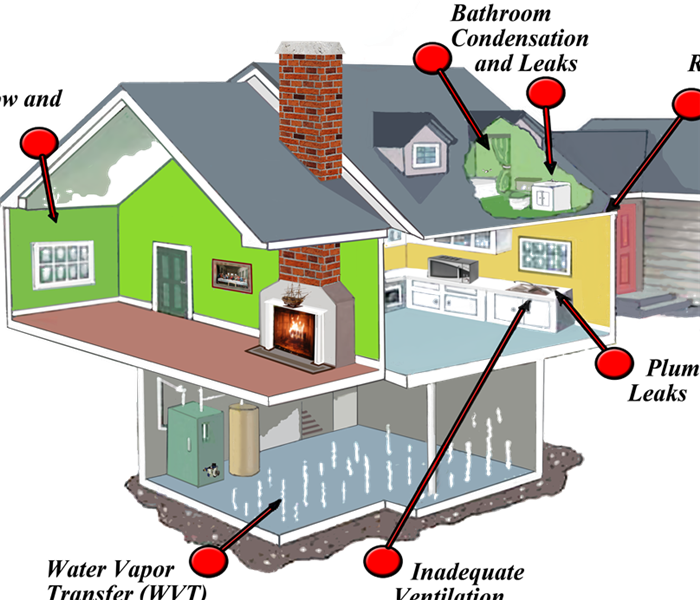 Mold can grow anywhere that moisture is prevalent. This includes basements, attics and bathrooms
Mold can grow anywhere that moisture is prevalent. This includes basements, attics and bathrooms
Does YourHome Have A Mold Problem?
Microscopic mold spores naturally occur almost everywhere, both outdoors and indoors. This makes it impossible to remove all mold from a home or business. Therefore, mold remediation reduces the mold spore count back to its natural or baseline level. Some restoration businesses advertise “mold removal” and even guarantee to remove all mold, which is a fallacy. Consider the following mold facts:
- Mold is present almost everywhere, indoors and outdoors.
- Mold spores are microscopic and float along in the air and may enter your home through windows, doors, or AC/heating systems or even hitch a ride indoors on your clothing or a pet.
- Mold spores thrive on moisture. Mold spores can quickly grow into colonies when exposed to water.These colonies may produce allergens and irritants.
- Before mold remediation can begin, any sources of water or moisture must be addressed. Otherwise, the mold may return.
- Mold often produces a strong, musty odor and can lead you to possible mold problem areas.
- Even higher-than-normal indoor humidity can support mold growth. Keep indoor humidity below 45 percent.
If your home or business has a mold problem, we can inspect and assess your property and use our specialized training, equipment, and expertise to remediate your mold infestation.
If You See Signs of Mold,Call SERVPRO of Salem/Peabody/Marblehead Today –978-744-4545
Mold Remediation Massachusetts
5/23/2017 (Permalink)
Mold Damage Restoration
Have you found evidence of mold contamination in various areas of your home? Did you know that it may not be possible for you to control the spread of mold spores all by yourself?
When you discover mold damage in your North Shore home, there are a few things you should know. Beginning with, we are available if you determine that your situation is out of control and you need professional assistance. SERVPRO technicians would like to help educate you more about why mold exists and how it makes its way into your home. It is a constant part of our environment; microscopic spores exist in the air that we breathe, the food that we eat, and almost every facet of our environment.
Mold is rather harmless in small quantities; it only becomes harmful when we provide it with the correct conditions to multiply. However, you should also know that it is impossible to remove it from your home entirely. You can limit the exposure that you experience by properly maintaining and controlling the different water sources that exist in your home.
At SERVPRO we highly suggest that if you discover a water-damaged area in your home, that you find the water source, clean and dry the affected area, or immediately seek help. You need to act quickly; mold only needs 24-48 hours to begin spreading. Your entire home could become infested before you realize what has happened. Mold spores can reach areas that you cannot see and make your situation extremely hard to control.
If you are only facing small patches of mold damage, you can likely handle the job yourself. However, anything larger than three square feet is entirely different. Attempting to handle large contaminated areas could cause you to spread the infection even further, without even knowing. Choosing to hire a professional, like SERVPRO Salem, is the best option.
If you notice that your heating, ventilation, and air conditioning system contains mold, you need to shut the system off entirely and seek professional cleaning services immediately. Running the system could cause you to spread the contamination, everywhere. When you are facing a mold damage situation and need professional help,
MOLD FAQs
5/23/2017 (Permalink)
What is mold?
Molds are fungi that can be found both indoors and outdoors. No one knows how many species of fungi exist but estimates range from tens of thousands to perhaps three hundred thousand or more. Mold grows best in warm, damp, and humid conditions and spreads and reproduces by making spores. Mold spores can survive harsh environmental conditions, even dry conditions that do not support normal mold growth.
What are some kinds of indoor mold?
Where is mold found?
Mold is found in virtually every environment and can be detected indoors and outdoors, year round. Mold growth is encouraged by warm and humid conditions. Outdoors it can be found in shady, damp areas or places where leaves or other vegetation is decomposing. Indoors, mold can be found where humidity levels are high, such as basements or showers.
Specific Recommendations on how to keep mold down
- Keep humidity levels as low as you can—no higher than 50% — all day long. Using an air conditioner or dehumidifier will help you keep the levels low, however, bear in mind that humidity levels change over the course of a day with changes in moisture levels and air temperature.
- Run a dehumidifier in enclosed spaces such as basements.
- Be sure the home has adequate ventilation, including exhaust fans.
- Add mold inhibitors to paints before application.
- Clean bathrooms with mold or mildew killing products.
- Do not carpet bathrooms and basements.
- Remove or replace previously soaked carpets and upholstery.
Dry Ice Blasting Mold Removal
2/17/2017 (Permalink)
Dry Ice Blasting Mold Removal
Dry ice blasting to is a relatively new technology that is fast becoming the method of choice to remove mold by environmentally concerned mold remediation specialists. Dry ice blasting effectively removes mold by blasting it with particles of dry ice fired under high pressure, in much the same way as a jet of water is shot from a pressure washer. The low temperature and high impact of the dry ice kills and removes mold without the need for scrubbing and sanding contaminated surfaces. Yet his method is 100% environmentally safe as it contains no chemicals or toxins, and emits no hazardous dust in the mold removal process.
Advantages: extremely effective, fast, non-toxic, no hazardous dust emissions, environmentally friendly, no scrubbing required, special nozzles allow access to hard to reach nooks and crannies.
Disadvantages: not cost effective for small areas
Efflorescence vs Mold
2/17/2017 (Permalink)
Efflorescence can look like a white mold. Moisture and dampness moving through basement concrete can cause spalling and degradation of the concrete. The signs of efflorescence and the white deposits are not mold. But the evidence of the efflorescence does indicate the presence of moisture.
Efflorescence is a crystalline deposit on surfaces of masonry, stucco or concrete. It is whitish in appearance, and is sometimes referred to as "whiskers". Efflorescence has been a problem for many years, and is a topic of much controversy. The formation of these salt deposits are not mysteries. Efflorescence is the white chalky powder that you might find on the surface of a concrete or brick wall. It can be a cosmetic issue, or it can be an indication of moisture intrusion that could lead to major structural and indoor air quality issues.
Efflorescence vs Mold
2/17/2017 (Permalink)
Efflorescence can look like a white mold. Moisture and dampness moving through basement concrete can cause spalling and degradation of the concrete. The signs of efflorescence and the white deposits are not mold. But the evidence of the efflorescence does indicate the presence of moisture.
Efflorescence is a crystalline deposit on surfaces of masonry, stucco or concrete. It is whitish in appearance, and is sometimes referred to as "whiskers". Efflorescence has been a problem for many years, and is a topic of much controversy. The formation of these salt deposits are not mysteries. Efflorescence is the white chalky powder that you might find on the surface of a concrete or brick wall. It can be a cosmetic issue, or it can be an indication of moisture intrusion that could lead to major structural and indoor air quality issues.
Mold is major problem in real estate. But Mold does not have to kill a transaction.
7/7/2016 (Permalink)
Mold is major problem in real estate. But Mold does not have to kill a transaction.
Here are 10 ways to save a deal and your hard earned commission when mold is involved in your transaction. These are 10 common scenarios our mold remediation company, SERVPRO Salem, Peabody Marblehead, sees regularly when working with real estate agents (buyers and sellers) on a daily basis.
Scenario 1: A few inches of mold is found in a small area of the home and your client is worried mold is everywhere.
No need to take a wrecking ball to the entire house when a little bit of mold is found!
Explain to your buyers or sellers that mold only grows where there is water or high relative humidity. If mold is identified around a single window where condensation is present, there is no need to start ripping out walls in other areas of the home that are dry. Focus on the area where the water and mold growth is occurring and remove the mold at its source (e.g. the drywall and wood trim around the window) and eliminating the water source (e.g. window condensation).
Once this is finished, there are other inexpensive, easy steps to take like scrubbing the air on all levels of the home with $100 HEPA air purifiers to remove the airborne mold spores. Again, you don’t need to take a sledgehammer to the rest of the house.
Close more deals by explaining to your buyers and sellers that in such a scenario the mold is confined to one small area and can sometimes be remediated by a “do-it-yourself” client with a few basic skills, or by a professional remediation company like SERVPRO for far cheaper than you would probably expect.
Scenario 2: Mold is disclosed in the listing agreement or later identified during an inspection and you and your client are unsure whether you need it tested.
If you already see mold, testing is almost always an unnecessary waste of money
It does not matter what type of mold you have – once identified, all mold should be treated the same way (i.e. in the manner we describe below in Scenario 8).
Testing can be useful in certain situations such as when someone identifies a moldy-like smell but cannot actually see mold anywhere. In this case, testing can help determine if the smell is indeed mold and the source of the presumed mold. Most of the time though the smell of mold will lead you right to a visible source of mold, making testing unnecessary.
But if you can already see visible mold, most of the time testing is a waste of time and money. This is a fact that most mold companies do not want you to know. But the reality is that testing is usually unnecessary in this scenario and will slow up the transaction. Further, the money allocated for testing could be used towards other things, like the remediation itself.
Close more deals by advising your clients that testing is almost never needed when mold is already visibly identified.
Scenario 3: Mold is identified and all parties involved are concerned about health effects and potential liability from mold.
Another fact most mold companies will not disclose: many health effects proclaimed to be caused by mold are not proven!
Hype and misinformation about mold and its impacts on our health flood the airwaves. Here’s the truth: What mold exposure does and does not do to the human body is a relatively new concern.
Sophisticated research is ongoing, and we will eventually know more about mold’s effect on health. The bottom line is that most of the severe adverse health effects associated with mold have not been proven, according to country’s leading medical authority, the Center for Disease and Control and Prevention. According to the CDC:
“A link between other adverse health effects, such as acute idiopathic pulmonary hemorrhage among infants, memory loss, or lethargy, and molds, including the mold Stachybotrys chartarum (Stachybotrys atra), has not been proven. Further studies are needed to find out what causes acute idiopathic hemorrhage and other adverse health effects. ” (emphasis added)
We are not doctors so please consult a physician if you believe you or someone you know is experiencing health problems from mold exposure. And do not get us wrong – it is unhealthy to live in a moldy environment. But much of what you hear and read about mold
is often based on sensationalism and not backed by science.
Close more deals by giving your clients the truth about health effects from mold exposure.
Scenario 4: “Black Mold” is identified and your buyer or seller is concerned that the mold is toxic.
Not all molds are toxic despite what you may hear or read.
Mold comes in a variety of colors. The dreaded “Black Mold” you have heard about so often in the media is not a species or specific type of mold.
Media reports of “Black Mold” often refer to molds that can produce toxins (specifically mycotoxins), such as groups of molds known as Stachybotrys. Note that mycotoxins will not always be produced when these types of mold are present. To put it another way, the presence of mold does not necessarily mean mycotoxins are present.
Much of what we know about mycotoxins is not well understood yet and ongoing research is needed. According to the EPA though, certain types of mycotoxins produced by the molds Aspergillus flavus and Aspergillus parasiticus are shown to cause cancer. However, the EPA goes on further to say that “Aspergillus flavus and Aspergillus parasiticus are not commonly found on building materials or in indoor environments.”
The Centers for Disease Control and Prevention also states: “There are very few reports that toxigenic molds found inside homes can cause unique or rare health conditions such as pulmonary hemorrhage or memory loss. These case reports are rare, and a causal link between the presence of the toxigenic mold and these conditions has not been proven.”
Close more deals by revealing the truth to your clients about “Black Mold” and toxic molds.
Scenario 5: Mold is disclosed or identified and you are not sure what to tell your seller or buyer.
Everything in this email is useful information to provide your buyer or
seller to give them peace of mind.
But one of the first things you may want to tell them is: Not all molds are bad!
Explain to your buyer or seller that mold is everywhere – in our homes, in our offices and in the fresh air we breathe outside.
Explain to them that many of the media reports on mold are over hyped and that mold is in fact a natural organism that most of the time makes life better. Mold improves our lives by breaking down dead leaves and trees, helping to make certain types of cheeses, and by being the basis of modern antibiotics like Penicillin.
Despite these useful purposes, too much mold in a home can pose a health risk. How much is too much? Currently, there are no federal guidelines that define exactly how much mold is unhealthy. This useful fact is very important for your client to understand.
Even though no federal standards currently exist, generally speaking, you should not be able to see actual mold growth or smell it. If you can, your home probably has too much mold and can be unhealthy.
Although mold can be hidden, such as on the backside of drywall, don’t worry. You can usually detect it through sight or smell.
Close more deals by educating your clients that it is impossible to find a completely mold free home because mold is in every home and serves many useful purposes in our environment. Educate them further that despite these facts about mold, you should not be able to see or smell mold in a home and if you can, the home has elevated amounts of mold.
Scenario 6: Mold is disclosed or identified but you are not sure whether you need to hire a professional to remove it.
In many cases minor mold problems (less than about 10 square feet of mold) can easily be handled by the home owner with a free weekend afternoon and a few basic supplies from the hardware store. For more info, see our article: “Do I need a Mold Professional?”
If your client prefers to hire a professional instead, mold remediation – when done by a professional and ethical company – should not be expensive for minor problems.
Close more deals by advising your clients that minor mold problems should never be costly to fix and can often be done by the “Do It Yourselfers” in one day.
Scenario 7: Your client is on a tight deadline to close and you are worried there is not enough time to remove the mold prior to the closing date.
No need to worry as most of the time, mold can be removed in a few days by a professional company and should not stretch out the time it takes to close the deal.
Close more deals by giving everyone peace of mind that mold remediation can usually be within 1-3 days.
Scenario 8: There is an extensive mold problem and a professional mold remediation company is needed to remove the mold before
the deal can close.
If a mold remediation company is needed, protect yourself from dishonest contractors by remembering one undeniable fact: Mold Remediation Is Not Rocket Science!
Do not let a mold removal company tell you otherwise in an attempt to justify their outrageous estimate. There are essentially just two basic steps involved in mold remediation: Containment (e.g. using poly sheeting to prevent cross contamination) and Contamination Removal (e.g. safely removing moldy drywall, scrubbing/sanding 2x4s, removing airborne mold spores with HEPA air scrubbers, etc.)
We are oversimplifying a bit. There are other considerations involved like safety protocols (e.g. wearing respirators, gloves, etc when needed), initial assessment, post remediation assessment, etc.
But be wary of any company or individual who implies that mold removal is as complex as open heart surgery. Knowledge is power. Once you understand that mold remediation is not complicated, you are an empowered Realtor. If you represent the seller, you can advise him or her to say, “Thanks, but no thanks,” when someone tries to tell them that a bedroom closet with a little bit of ceiling mold is going to cost $10,000 to remediated. We have seen such outrageous bids before by other companies!
There are plenty of honest mold removal companies too. Just do your homework, get multiple bids and educate yourself on the procedures needed to remove mold.
Close more deals by helping your clients find reputable mold remediation companies that won’t rip them off or give them a price for remediation that is so high it kills the deal.
Scenario 9: Unexpected mold is found in an attic or crawlspace during an inspection.
In real estate transactions, the discovery of mold in an attic or crawl space by an inspector often comes as an unexpected surprise to the parties involved. But mold in attics and crawl spaces do not need to kill a transaction.
Don’t kid yourself. Mold in these places needs to be remediated. In extreme cases, it can be a sign of bigger issues such as foundation problems or roof deficiencies. But a buyer who falls in love with a house should not necessarily be shocked if mold is found in an attic or crawl space by an inspector.
These two areas of the home are ripe for mold infestation – we have read some studies that indicate as much as 60% of all crawl spaces have mold.
But often attic and crawl space mold goes undetected by the homeowner because these are not places most of us spend much time in.
Close more deals by educating your clients that unexpected attic and crawl space mold is common but that the buyer can still live safely without worry if the remediation is done properly. Or if you represent the seller, attic and crawlspace mold can be removed and fixed like any other part of the house by a professional mold remediation company.
Scenario 10: Mold problems indicate water problems since mold can only grow where water is present.
This is less of a “scenario” but more of an important fact to keep in mind about mold whether you are representing the buyer or the seller.
Help your client understand that the presences of mold can be seen as a good thing – i.e. it alerts the buyer/seller of a bigger water issue and helps prevents the parties involved from being “caught off guard” after the closing.
And remember that water problems can not only trigger mold growth but can also damage building materials and reduce the longevity of the home.
Close more deals by reminding clients that although mold is undesired, it can be useful in helping to identify a potentially bigger water issue.
Does Your Salem, Peabody, Marblehead, Swampscott, or Middleton Home Have A Mold Problem?
4/27/2016 (Permalink)
In Salem, Peabody, Marblehead, Swampscott, or Middleton, mold can spread through a home in as little as 48 hours.
Microscopic mold spores naturally occur almost everywhere, both outdoors and indoors. This makes it impossible to remove all mold from a home or business. Therefore, mold remediation reduces the mold spore count back to its natural or baseline level. Some restoration businesses advertise “mold removal” and even guarantee to remove all mold, which is a fallacy. Consider the following mold facts:
- Mold is present almost everywhere, indoors and outdoors.
- Mold spores are microscopic and float along in the air and may enter your home through windows, doors, or AC/heating systems or even hitch a ride indoors on your clothing or a pet.
- Mold spores thrive on moisture. Mold spores can quickly grow into colonies when exposed to water. These colonies may produce allergens and irritants.
- Before mold remediation can begin, any sources of water or moisture must be addressed. Otherwise, the mold may return.
- Mold often produces a strong, musty odor and can lead you to possible mold problem areas.
- Even higher-than-normal indoor humidity can support mold growth. Keep indoor humidity below 45 percent.
If your home or business has a mold problem, we can inspect and assess your property and use our specialized training, equipment, and expertise to remediate your mold infestation.
If You See Signs of Mold, Call Us Today – 978-744-4545






 24/7 Emergency Service
24/7 Emergency Service













